Jake Stringer’s snap for goal changes trajectory as it is touched by Dayne Beams. The shot led to two errors in the one incident. Picture: FOX FOOTY
RoCo’s Wrap: 10-metre rule and video reviews are a farce
The AFL bye rounds are always a challenge, both for the fans and the fixturers. And with the standard of football we’ve been watching a big talking point of late, the next couple of weeks could be nervous ones for the league.
Round 12 has given us seven games, and for the next fortnight it’s just six, Thursday night games spreading the schedule even thinner, with six days over those two rounds when just one game will be played. It wouldn’t take too many shockers for the whole “game’s in a mess” narrative to explode again.
To that end, there’s a lot riding on the Queen’s Birthday blockbuster between Melbourne and Collingwood.
And would have been even more were it not for a pretty decent stoush late on Sunday afternoon in Perth between Fremantle and Adelaide, in terms of spectacle easily the pick of the half-dozen games before the Monday holiday.
The Crows haven’t had much luck on the injury front, but if Melbourne beats Collingwood at the MCG, they’ll be three games adrift of the top four with 10 to play, and in flag terms, perhaps beyond saving.
Port Adelaide’s defeat of Richmond had importance if not many thrills, Greater Western Sydney looks to be back on-song, and Geelong and Sydney continue to get the job done.
But surely only those with completely vested interests would argue that to date this had been a riveting season. And while there will be plenty of discussion about potential solutions to congestion, low scoring and ugly football generally, there’s a couple of things not helping the general sense of disaffection which are of the AFL’s own making.
The level of irritation about both the policing of the 10-metre protected area and the use of the video review system has reached new highs, and after a couple of farcical episodes on Saturday and Sunday, with pretty good reason.
Let’s start with the protected area. It was introduced for the 2016 season supposedly to improve the ability of teams to move the ball back into the corridor, speed up ball movement generally, help ease congestion and in turn raise scoring.
Has it done so? Hardly. Contested possession and tackle numbers have continued to rise since its inception and last year we averaged only three fewer around-the-ground ball-ups than back in 2015.
As for scoring, well the past four seasons have been the lowest-scoring since 1970. This season, with an average points per team of just 83 at the completion of the last round, we’re on track for the single lowest-scoring season since 1968.
So those problems haven’t been addressed. Far worse, though, more have been created both in the inconsistency with which the protected area has been enforced, and more fundamentally, the confusion among both players and viewers.
At the start of this season, the umpires were red-hot on it. Just as quickly, they backed off. Until last weekend, when the crackdown was on in earnest, the Hawthorn-Port Adelaide game alone delivering a record 11 50-metre penalties, the vast majority for infringements in the protected zone. In several of those, the players infringing had zero impact on the player with the ball’s options.
But the nadir may have been reached on the weekend. First, in the Geelong-North Melbourne game, at a critical stage early in the last quarter, Gary Ablett was pinged for entering the protected zone when he was running away from and not even looking at Todd Goldstein, much less interfering with play. Result, a goal to Goldstein.
Then at the Gabba on Sunday, Brisbane’s Zac Bailey was also pinged after a mark taken by Essendon’s Anthony McDonald-Tipungwuti. The Bomber at no stage looked to play on and when the whistle was blown, Bailey was already behind even the man on the mark, Nick Robertson. Result, another 50, another goal.
The old five-metre zone at least had some rationale, as players within that distance could realistically impact on the play about to take place. Not only has the expansion to 10 metres failed to correct anything, all it has produced is a series of players with no intention of getting involved, or worse, actively trying to escape the area, paying a ridiculously harsh price for next to nothing.
The video reviews? Well, far from improving, the system seems to have got worse again this season, not only in terms of correct calls but the entire process followed. Two more incidents from those same two games highlighted as much.
At Geelong, North’s Ben Cunnington had a snap apparently touched either by the Cats’ Sam Menegola or Tim Kelly. The field umpire called touched but told players the decision had to be reviewed.
Why? If he’d said “all clear”, you could at least argue a case for the review, though the merits of vision shot 30-odd metres away in establishing whether a ball has flicked a finger on the way through are very debatable.
But if an umpire on the scene thinks the ball has been touched and calls it, it’s been touched, hasn’t it? Otherwise the clear implication is that he’s guessing. And aren’t umpires instructed not to guess?
Yet what followed at the Gabba on Sunday was worse again. Jake Stringer’s snap in the final couple of minutes was also called touched by the umpire, who told players because he’d called it, it had to go upstairs. Replays this time actually were conclusive. A side-on view showed the entire trajectory of Stringer’s shot changed as Brisbane’s Dayne Beams got a hand to it.
But instead, we got two mistakes for the price of one, a repeat of the flawed process for the touched ball, plus an inexplicable overrule of the original decision and a goal awarded.
Not for the first time in professional sport, video review in the AFL has exceeded its original brief, to call out glaring errors, specifically shots that may have hit a post or been touched on the goal line, where the cameras are in the right position to make a call.
Now there’s more grey areas, more opportunities for judgement errors, and on the weekend, most disturbingly, errors in the philosophy behind those calls, that by their very definition suggest the umpires are guessing. Really, it’s garbage.
The way the game is coached and how it looks as a result isn’t necessarily the fault of the AFL, and to be fair it does seem to be heeding the concerns of a growing chorus of voices that action needs to be taken.
But at a time when football fans don’t need much encouragement to tip a bucketload on the state of the competition, the increasing sense of comedy capers around both the protected area rule and the video review process are classic examples of the league shooting itself in the foot.
And I’d strongly suggest that before the newly-formed “competition committee” starts looking at zones or further reducing the interchange cap, it fixes up this far more embarrassing mess first.

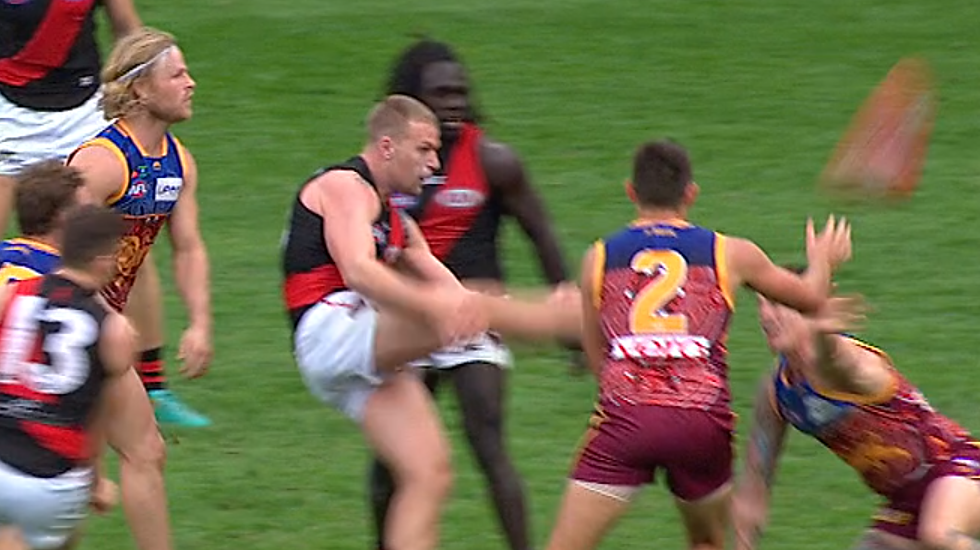
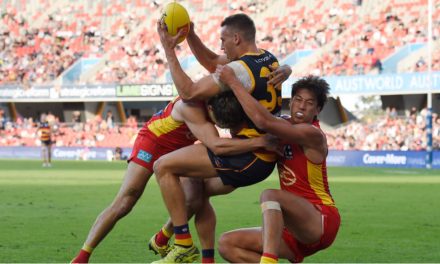
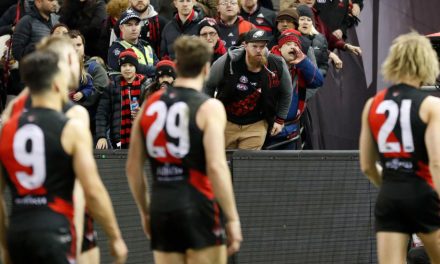
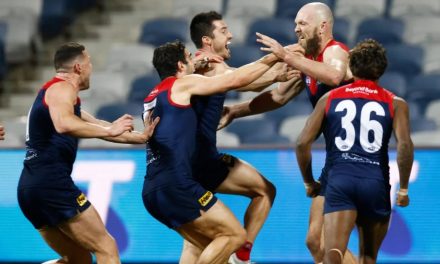
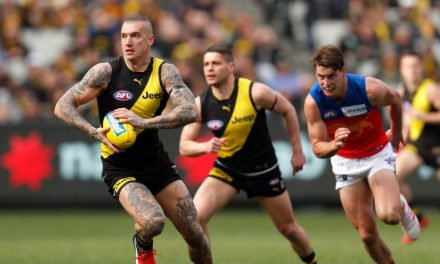



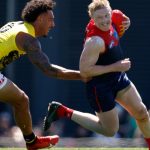


I didn’t have any hope for the video review system because of what happened in cricket, where the same problems we’re seeing in footy had already happened.
1) Umpires lose confidence in themselves and become afraid to make an affirmative decision in case it might be wrong, even if only very marginally so. And even the video review umpire becomes afraid to make a decision and starts seeing things no one else does.
2) The system gets introduced to “eliminate howlers” as in cricket or overturn the “conclusive” ones in footy… but in both cases, it ends up getting used for line ball decisions that really could go either way, ones that should stay with the umpire’s call, but are instead being adjudicated upstairs.
The umpire on the video review, whether footy or cricket, should be banned from more than 2 viewings of any camera angle. If they can’t see it in 2, it’s not conclusive and it’s not a howler.
And then the **media** must play their part and not make an issue about the line ball ones that only on several viewings could be seen to possibly be wrong.
Because, when all the fluff is cleared away, it is the media (usually in the form of the broadcaster) who put us in this situation with their over analysis and excessive criticism.
(On the Ablett 10m penalty, I think the umpire probably felt Ablett was not taking the shortest route out of the 10m area, which is probably not an unreasonable decision then.)